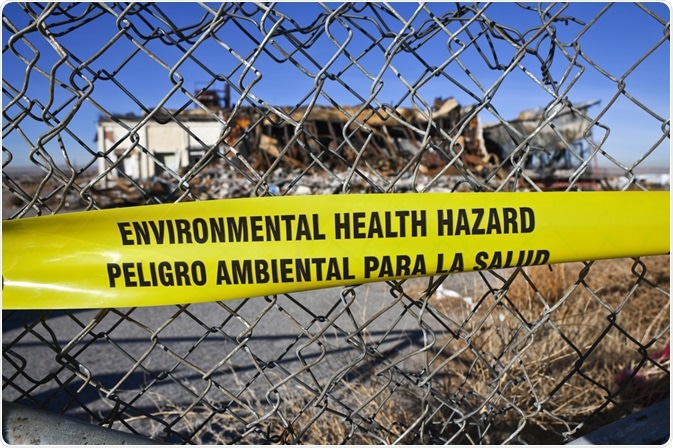What are environmental health hazards?
Humans share an interactive relationship with the environment. Biological, physical, chemical, biomechanical, and psychosocial factors in the environment affect humans, who in turn exert an impact on the environment. Potentially, this interactive relationship exposes humans to environmental health hazards. These include any environmental situation or factor that can lead to disease, injury, or death.
Environmental Health Hazard. Image Credit: trekandshoot/Shutterstock.com
Environmental hazards can impact public health directly or indirectly, and range in impact from subtle to acute. Some examples include:
The Bhopal disaster in India, 1984
A gas leak incident at a pesticide plant in Bhopal led to half a million people being exposed to methyl isocyanate gas, a highly toxic irritative material. 200,00 people were poisoned, leading to acute lung, kidney, and liver disease, and over 2,000 died.
Minimata disease, Japan, 1956
A neurological disease first identified in the city of Minimata, caused by severe mercury poisoning. It was caused by the release of mercury from the industrial waste of a chemical factory into the sea over thirty years. It entered the food chain via fish and shellfish, causing human death over many decades and congenital diseases.
Pesticide use, California, 1985
The insecticide aldicarb, a carbamate used to control insects, spiders and ticks was inappropriately used at a watermelon farm. Upon ingestion of the watermelon, approximately 1000 people developed gastrointestinal, muscular, and autonomic effects.
Types of environmental hazard
Hazards can be classified as follows:
Physical
Conditions, equipment, or substances that endanger physical safety. They include fire, radiation, poorly managed or maintained machinery.
Biological
Organisms that are hazardous to humans, and include parasites, viruses, and toxins produced by organisms. This group of hazards are responsible for the majority of human diseases, including HIV, hepatitis, cholera, and tuberculosis.
Chemical
Including solid, liquid, and gaseous chemicals, these hazards are present when humans are exposed to harmful chemicals in their environment. They cause health effects that are acute (as in Bhopal) or chronic (as in Minimata) and can be inhaled, ingested, or exposed via skin contact.
Cultural
The term culture refers to the ideas and customs of a given society, some of which can adversely affect health. Examples include the practice of female genital mutilation and open defecation.
Social
Social factors such as poverty, obesity, and drug abuse may lead to physical and mental dissatisfaction and chronic illnesses.
Environmental pollution as a hazard
Pollution can be defined as any substance or form of energy, including sound, heat, or radiation that contaminates the environment, and causes harm to the ecosystem by promoting a change to the environment.
Major pollutants include air, water, and land pollution and occur when the addition of the pollutant occurs at a faster rate than the pollutant’s dispersal.
How can hazards be managed?
Managing the impact of environmental hazards involves utilizing monitoring and control techniques. Establishing and implementing routine measurements to monitor changes in either the environment or public health, promoting early identification and intervention, can reduce the risk that hazards present.
Monitoring can use data from various sources including health data, bio-monitoring data, and emissions inventories. Controls require setting thresholds for acceptable levels of exposure and establishing what level of control is required to keep exposure under the said threshold.
What environmental hazards are controlled?
Water and food
In the developed world, rigorous quality standards for physical, biological, and chemical qualities of drinking water are set and monitored throughout water treatment and distribution networks. Such tests include pH levels, dissolved metals, and metalloids such as lead or mercury, chlorination by-products, and antigens such as E coli.
Testing in the food industry takes an approach based on the principles of the Hazard Analysis and Critical Control Points (HACCP), which seeks to identify potential hazard points and apply actions to remove hazards or reduce them to safe levels. The three main food hazards are microbiological, chemical, and physical.
Air
Air quality has a direct and significant impact on respiratory health. The primary focus has been on protecting the quality of the outside air by controlling pollutants such as carbon monoxide, nitrogen dioxide, and lead which can cause chronic public health issues.
Over the past hundred years, attention has been turned to ‘air toxics’, organic chemicals consisting of molecules such as carbon and hydrogen, and more recently to the control of greenhouse gases.
Ionizing and electromagnetic radiation
Ionizing radiation is a type of energy released in the form of electromagnetic waves, such as gamma or x-ray, or particles such as neutrons. Whilst ionizing radiation has many useful applications, including use in medicine, industry, and agriculture, it also brings the potential for health hazards if not appropriately contained.
Beyond safe thresholds, radiation exposure can cause acute effects such as radiation burns, skin redness, and radiation syndrome, a severe collection of health effects that can lead to death.
References:
- D’Haenens, J. P., McDonald, K. W., Langley, R. L., Higgins, S. A., Scott, R., Farquhar, P. N., & Meggs, W. J. (2013). Aldicarb: a case series of watermelon-borne carbamate toxicity. Journal of agromedicine, 18(2), 174–177. https://doi.org/10.1080/1059924X.2013.766141
- Kamiya, K., Ozasa, K., Akiba, S., Niwa, O., Kodama, K., Takamura, N., Zaharieva, E. K., Kimura, Y., & Wakeford, R. (2015). Long-term effects of radiation exposure on health. Lancet (London, England), 386(9992), 469–478. https://doi.org/10.1016/S0140-6736(15)61167-9
- www.cdc.gov. (2020). National Environmental Public Health Tracking | Tracking | NCEH | CDC. [online] Available at: https://www.cdc.gov/nceh/tracking/.
- Food Standards Agency (2017). Hazard Analysis and Critical Control Point (HACCP). [online] Food Standards Agency. Available at: https://www.food.gov.uk/business-guidance/hazard-analysis-and-critical-control-point-haccp.
Last Updated: Jun 22, 2021

Written by
Clare Knight
Since graduating from the University of Cardiff, Wales with first-class honors in Applied Psychology (BSc) in 2004, Clare has gained more than 15 years of experience in conducting and disseminating social justice and applied healthcare research.
Source: Read Full Article

